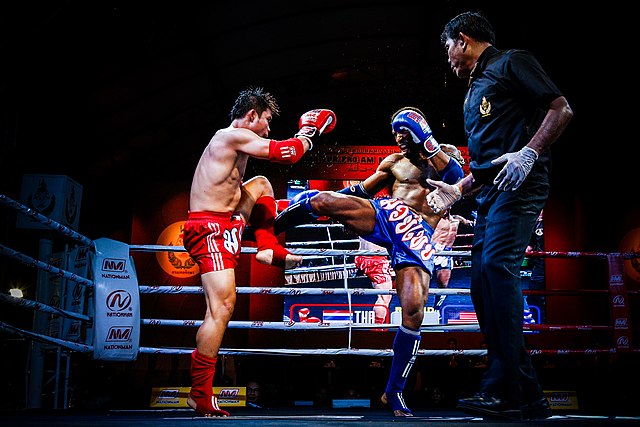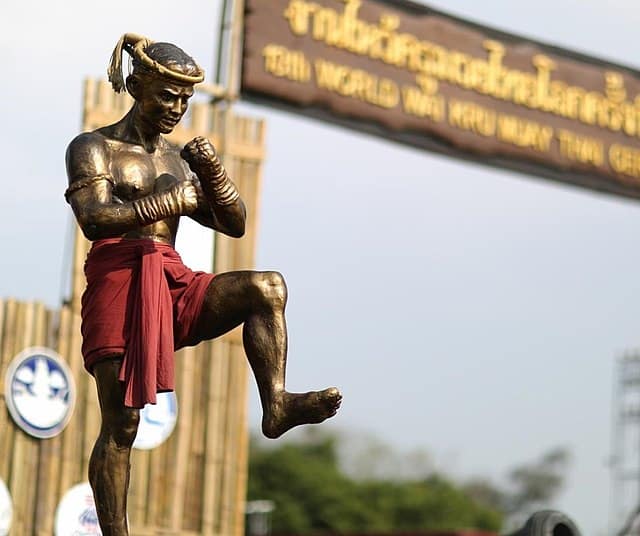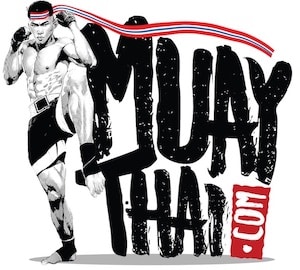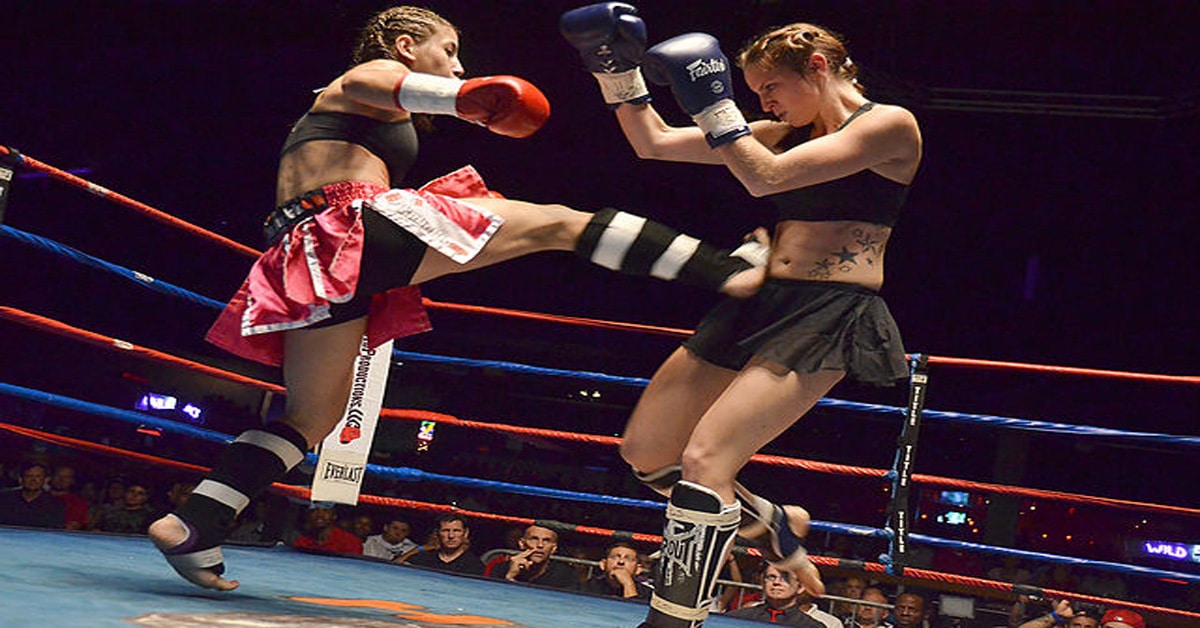Thai Boxing: Muay Thai, Everything You Need To Know
The sport of Thai boxing is more popular than ever, with millions of fans worldwide. It’s the fastest-growing combat sport in the world, which is on the edge of blowing up.
Here is what you need to know about the sport of Thai boxing. Going over Muay Thai’s history, how it developed into a sport, and the combat rules.
What is Thai Boxing?
Thai boxing, or Muay Thai, is the official sport and martial art of the nation of Thailand. The martial arts dates back centuries, but the modern version of the sport is rather young.
It’s a sport of kickboxing that uses punches, kicks, elbows, knees, clinches, and sweeps to beat an opponent. Early forms of the sport can be dated back to the 16th century and evolved into modern Thai boxing over time.

The History of Thai Boxing
The history of the sport of Thai boxing can be traced to the 16th century during the reign of King Naresuan (1555 to 1605). At the kingdom’s annual festivals, Naresuan would get his best Muay Thai warriors to compete in friendly sparring competitions.
The warriors would wear cloth and hemp ropes around their hands as they fought in dirt/sand circles. This tradition continued for centuries as formal Muay Thai training was developed through the centuries.
In the 18th century, Thai boxers would venture into neighboring rival countries to challenge their best fighters. Fighters from Thailand, Myanmar, Laos, and Cambodia all practiced a style similar to Thai boxing and competed against each other.
During the 20th century, Western countries were gradually introduced to Muay Thai due to WWI. The Thai soldiers sent to Europe would compete in exhibitions put on by their commanders to boost morale.
French and English soldiers watched some of these early Thai boxing matches and were mesmerized. At the same time, Thai boxers were introduced to Western boxing and Savate, the French kickboxing style.
The Thai boxing practitioners were introduced to boxing rings, Western-style boxing gloves, and the Queensberry boxing rules.
When the Thai returned to their country, they began developing the modern style of Thai boxing. They adopted the use of boxing rings, gloves, time limits, weight classes, and official rules of the sport.
The sport of Muay Thai became both the national martial art and sport of Thailand. Around the country, official Thai boxing stadiums, promotions, and fight gyms were constructed.
Near the beginning of the 20th century, Westerners began traveling to Thailand to learn and compete in the sport. It is now a globally practiced sport that is loved by millions across the world.

The Rules of Thai Boxing
Thai Boxing promotions generally use the same rule sets for their bouts. Here are the official rules of Thai boxing and in this article we break down the Muay Thai scoring system.
- Thai Boxing Ring: A size of 7 x 7 meters or around 24 x 24 feet
- Thai Boxing Referee: The referee is responsible for whatever occurs during a fight.
- Thai Boxing Judges: 3 official ringside judges are present to score the fights.
- Permitted Techniques: Punches, Kicks, Elbows, Knees, Clinches, Sweeps, Grabs, Throws
- Time Limit: 5 rounds at 3 mins each, with 2 mins rest between each round.
- Fighting Attire: shorts, gloves, mouthguards, cups, and taping feet is voluntary.
- Scoring: 10-Point Scoring System
- Ways To Win: KO, TKO, Doctor Stoppage, Decision, DQ
- Prohibited Techniques: Headbutts, Eye Gouging, Low Blows, Hitting Downed Opponent, Stomps, Striking Back of Head
- 10 Counts: Knockdown fighters are given until ten to get up and an automatic standing 8 count. If they can’t get up, the bout is ruled a KO or TKO.
- Knockdown Rule: Some promotions use a knockdown rule, where a fight ends if a fighter is knocked down a certain number of times.
- Decisions: The judges will decide the winner if no KO or TKO is recorded during a Thai boxing bout.
- Draw: Draws can be declared when judges cannot decide on a clear winner.
- Point Deductions: Points can be deducted from a fighter for repeated illegal offenses.
The Weight Classes
Just like in boxing, Thai boxing organizes fights by dividing fighters into weight classes. There are a variety of weights going from strawweight to heavyweight divisions. Here’s an example of Thai boxing weight classes used at famous Muay Thai stadiums.
- Mini Flyweight weight over 100 lbs but not exceeding 105 lbs. (47.629 kg.)
- Junior Flyweight weight over 105 lbs but not exceeding 108 lbs. (48.990 kg.)
- Flyweight:108 to 112 lbs (50.8 kg.)
- Junior Bantamweight: 112 lbs to 115 lbs. (52.16 kg.)
- Bantamweight: 115 lbs to 118 lbs. (53.5 kg.)
- Junior Featherweight: 118 lbs to 122 lbs. (55.34 kg.)
- Featherweight: 122 lbs to 126 lbs. (57.15 kg.)
- Junior Lightweight: 126 lbs to 130 lbs. (59 kg.)
- Lightweight: 130 lbs to 135 lbs. (61.238 kg.)
- Junior welterweight: 135 lbs to 140 lbs. (63.5 kg.)
- Welterweight: 140 lbs to 147 lbs. (66.68 kg.)
- Junior Middleweight: 147 lbs to 156 lbs. (70.76 kg.)
- Middleweight: 156 lbs to 160 lbs. (72.5 kg.)
- Junior Heavyweight: 160 lbs to 175 lbs. (72.57 kg.)
- Heavyweight: 175 lbs (79.38 kg.) and up.
The Golden Era of Thai Boxing
Like in the sport of Boxing, Thai boxing had its own golden era. This was when many experts and fans believed Muay Thai was at its best and fighters were the most skilled.
The golden era of Thai boxing started around the late 1970s and continued into the early 1990s. This was when the sport took a giant leap into modernity.
Champion Thai boxers became superstars who made more money and were loved by millions of fans. It marked the start of Muay Thai’s expansion and introduction into the West.
Western fighters like Rob Kaman, Ramon Dekkers, and Dany Bill debuted in Thailand along with many Thai champions.
The top fighters of the golden era were legends who changed the sport. Many golden-era fighters would continue working as trainers after retiring from the sport. Continuing to grow the sport and prepare the next generation of fighters.
What’s the Difference Between Thai Boxing & Muay Thai
Muay Thai and Thai boxing are interchangeable terms that mean the same thing. It’s the name used for both the martial arts and the sport of Muay Thai. Thai boxing is another name predominantly used when referring to the sport of Muay Thai.
Is Thai Boxing Different Than Muay Boran

Muay Boran is a Thai martial art that is the precursor to Muay Thai. Before the sport of Thai boxing was established, Muay Boran was the martial art used for war.
Early Siamese and Thai soldiers practiced it throughout the history of Thailand. Without Muay Boran, there would be no Muay Thai (Thai boxing).
Is There a Ranking System in Thai Boxing?
There is no formal ranking system within Muay Thai. However, some lineages of Thai boxing gyms will use a ranking system that consists of colored armbands to distinguish ranks.
Here’s the World Thai Boxing Association (WTBA) ranking system.
Beginner Armbands
- White Band
- Yellow Band
- Orange Band
Advanced Armbands
- Green Band
- Blue Band
- Purple Band
- Red Band
- Brown Band
- Black Band
Thai Boxing vs Lerdrit
Thai boxing has many different variations and one of the notable styles of Lerdrit. Muay Lerdrit is the updated military style of Thai boxing practiced by the Royal Thai Military. It’s basically an updated version of Muay Boran developed for the modern Thai soldier.
Popularity Today
Thai boxing is more popular today than ever before and is on the edge of increasing popularity. Millions of Thai boxing fans recently watched champions Rodtang and Superlek put on an all-time classic.
Views of the fight throughout the internet are reaching to nearly 100,000,000 views. It’s a beautiful sport and is now going to be practiced and watched by millions more across the world.


